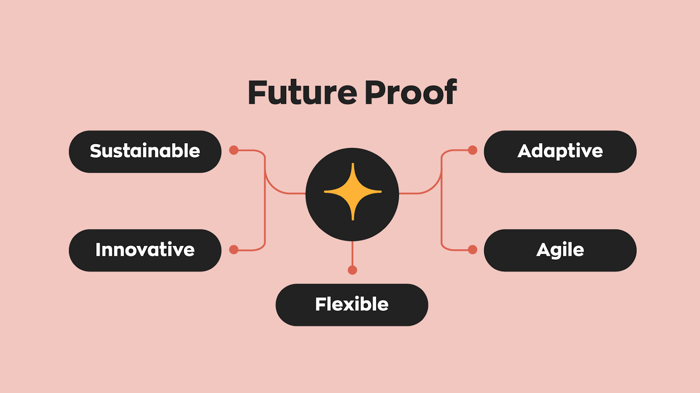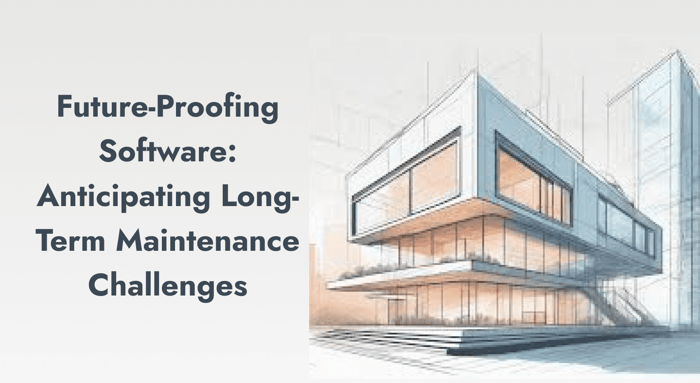Table of Contents
Learn how to anticipate long-term maintenance challenges in software development processes
TL; DR
In today's dynamic business landscape, companies that fail to adapt to new challenges and innovations inevitably lag. According to the Harvard Business Review, the utilization of automation and analytics surged during the COVID-19 pandemic, while identifying and training individuals with critical business skills became increasingly vital. Forbes also underscored the importance of companies anticipating future trends by focusing on the needs of customers and employees, building versatile workforces, and implementing agile processes to address future demands and unforeseen challenges.
Future-proofing in software development means creating and implementing relevant, functional, and adaptable software as technology changes. This is important for sustainable software development and to avoid the need for big changes in the future. Whether the software is for internal use or external applications, it's crucial to think about its long-term viability. Future-proofing makes sure that software can change over time, so you don't have to replace it or change it extensively. Companies that don't focus on future-proofing have to make tough choices when their software becomes outdated. So, every software design needs to invest in future-proofing. However, this process can be challenging because technology changes quickly.
Neglecting these considerations can impede a company's ability to compete and survive in the long run within its industry. In contrast, companies that future-proof their operations will be better equipped to navigate the rapid changes occurring in their industry.
This blog presents strategies for predicting and mitigating long-term maintenance challenges, ensuring that software remains resilient and adaptable in the ever-evolving technological landscape.
Understanding Long-Term Maintenance Challenges
Long-term software maintenance involves post-delivery modifications and updates to sustain the system's functionality and efficiency in meeting user requirements. This critical phase in the software development life cycle (SDLC) involves planned and unplanned activities to ensure the software remains reliable and aligned with evolving technological landscapes, requirements, and user expectations, thus extending its lifespan.

Common issues that teams encounter during their software maintenance efforts include but are not limited to:
Undocumented Changes: Adjustments made without proper documentation can cause conflicts and difficulties in future maintenance.
Legacy Code: Older systems built with outdated technologies require specialized knowledge, complicating maintenance efforts.
Complexity: Large and complex systems can be challenging to understand and modify, making problem identification and resolution difficult.
Changing Requirements: Evolving user needs necessitate software modifications, which can be time-consuming and challenging.
Interoperability Issues: Systems needing to work with other software can be difficult to maintain, as changes in one system can affect the others.
Lack of Test Coverage: Poorly tested systems make it hard to identify and fix problems without understanding system behavior in various scenarios.
Lack of Personnel: Insufficient skilled personnel can hinder the maintenance and updating of the system.
High Costs: Maintenance can be expensive, especially for large and complex systems, making budgeting and management difficult.
Lack of Documentation: Poor documentation can make understanding the system’s workings hard, complicating problem identification and resolution.
Lack of Code Comments: The absence of comments in the code makes it difficult for developers to understand and maintain the system.
Outdated Internal Processes: Legacy processes can impede the effective use of new maintenance software.
The longevity of software is significantly influenced by the evolution of technology, changing requirements, and shifting user expectations. Continuous updates and modifications are essential to keep pace with rapid technological advancements and evolving user needs. Proactive planning and foresight are crucial to ensure the software remains relevant and meets current requirements.
Establishing a well-defined maintenance process, encompassing regular testing, validation, version control, and effective stakeholder communication, is essential for maintaining robust and adaptable software. Alongside this, a skilled team and clear maintenance plans, including routine activities such as testing, backup, and bug fixing, are critical for ensuring long-term software sustainability.
What Does Future-Proofing Really Mean?
The concept of future-proofing software involves the creation of solutions that demonstrate longevity and adaptability as technology and user requirements progress. This entails developing software that can seamlessly evolve to meet new demands and modifications without requiring costly rewrites or extensive adjustments. This strategy guarantees that the software can consistently meet evolving user needs and industry benchmarks. Future-proofing is a critical aspect of sustainable software development, as it mitigates long-term maintenance issues and maximizes the software's return on investment.

An often misunderstood concept about future-proofing is the belief that it entails creating software that will never require modifications. In reality, it is unattainable to develop software that remains static and pertinent over time. Given the rapid evolution of user requirements and technological landscapes, change is inevitable. Future-proofing, therefore, revolves around constructing software that can effortlessly and effectively adapt to these changes. This necessitates the adoption of flexible architectures, modular designs, and open standards that facilitate seamless updates and integration with emerging technologies.
Future-Proofing Software vs. Developing A Minimum Viable Product
The concept of future-proofing differs significantly from that of developing a Minimum Viable Product (MVP). An MVP is a rudimentary version of a product that includes just enough features to be used by early adopters, who can then provide feedback for future development. The primary objective of an MVP is to swiftly validate a product idea with minimal investment. It prioritizes speed, market testing, and iterative development based on user feedback. While an MVP assists in understanding market needs and validating concepts, it does not prioritize long-term adaptability or scalability.
In contrast, future-proofing involves looking beyond immediate validation and market entry, focusing on the software’s long-term sustainability. It ensures that the software can expand and adapt to future demands without necessitating complete rewrites or significant investments. This entails anticipating potential challenges, implementing scalable architectures, and ensuring compatibility with emerging technologies. Both approaches have their place in software development; the choice depends on the project’s goals and timeline. While MVPs are crucial for initial market testing, future-proofing guarantees that the software remains viable and efficient in the long run.
Future-Proofing Strategies
Future-proofing software involves ensuring that a system maintains adaptability, efficiency, and relevance as technology and user requirements advance. By employing strategic methodologies, developers can design software that reduces the necessity for significant rework or overhauls. Below, we will discuss essential strategies for future-proofing software:
Embracing emerging technologies and platforms with long-term support: To maintain the relevance and efficiency of software, it is imperative to embrace emerging technologies and platforms with long-term support. This entails continual monitoring of technological trends and the evaluation of new tools and frameworks to improve functionality and performance. Adopting technologies with strong community support and backing helps reduce the risk of obsolescence and ensures compatibility with future advancements. Pilot programs can validate these technologies before full-scale implementation, minimizing disruption and maximizing the potential for seamless integration.
Building scalable and extensible architectures: Designing scalable and extensible architectures is crucial for ensuring the future-proofing of software development. This can be achieved through the creation of modular systems that enable independent updates and seamless scalability. Service-oriented architecture (SOA) and microservices are highly effective, allowing for the development, deployment, and independent scaling of discrete services. This modular approach guarantees that evolving user needs and the integration of new features can be accomplished without major overhauls, saving both time and resources while preserving system integrity.
Establishing contingency plans and disaster recovery mechanisms: To future-proof a system, it's crucial to establish robust contingency plans and disaster recovery mechanisms to prepare for unexpected events. This involves implementing regular data backups, restore points, and redundant systems to ensure that critical information and functionalities remain intact even in the face of unforeseen events. Conducting comprehensive risk assessments is essential to identify potential vulnerabilities and develop strategies to mitigate them. These proactive measures contribute to business continuity, minimize downtime, and protect against data loss, thereby maintaining trust and reliability.
Designing for maintainability: To create maintainable software, it's crucial to follow clean code and modular architecture principles. Writing clear, understandable, and well-documented code simplifies future system modifications. Embracing software design patterns and best practices ensures standardized and reusable solutions to common problems. It's essential to balance flexibility and simplicity, as overly complex systems lead to maintenance challenges, while overly simplistic designs struggle to adapt to future needs. A maintainable codebase is vital for long-term sustainability and ease of updates.
Documentation and knowledge management: Comprehensive documentation and effective knowledge management are pivotal for ensuring the longevity of software systems. Thorough documentation covering system architecture, functionalities, and technical specifications facilitates efficient understanding and collaboration among team members. Encouraging knowledge-sharing practices within development teams, including the use of code repositories and collaboration tools, fosters a culture of continuous learning and enhancement. By utilizing centralized documentation and collaboration platforms, teams can maintain consistency and accessibility, thereby facilitating seamless transitions and onboarding processes for new members.
Test-Driven Development (TDD) and Automated Testing: Adopting test-driven development (TDD) and automated testing frameworks is essential for establishing high software reliability and maintainability standards. TDD encourages writing tests before code implementation, enabling early bug detection and enhancing code quality. A comprehensive set of automated tests, encompassing unit, integration, and regression tests, is critical for preventing the introduction of new issues during changes. Continuous integration and deployment (CI/CD) pipelines further optimize the testing and deployment processes, facilitating frequent and dependable releases. These methodologies collectively uphold software stability and adaptability in the face of future modifications.
Addressing legacy systems and technical debt: The effective management of legacy systems and technical debt is crucial for ensuring long-term viability. Utilizing strategies like incremental refactoring and code analysis tools is essential for modernizing legacy codebases and bringing them in line with current industry standards. Prioritizing initiatives to reduce technical debt is key to preventing the accumulation of inefficient and outdated code, which can impede future development. Striking a balance between short-term business needs and long-term technical sustainability is vital for ensuring that systems remain efficient and maintainable, thereby mitigating the risk of expensive overhauls in the future.
Monitoring and maintenance tools: Incorporating robust monitoring and maintenance tools is critical for ensuring the longevity of software. Real-time monitoring and alerting systems like Prometheus and Grafana empower teams to swiftly identify and address issues. By utilizing analytics and telemetry data, teams can make informed maintenance decisions and optimize performance according to real usage patterns. By proactively engaging in maintenance practices, such as regular updates and performance tuning, teams can prevent downtime and performance degradation, thus ensuring the long-term efficiency and reliability of systems.
The combination of these future-proofing strategies reinforces the adaptability, maintainability, and resilience of software systems, resulting in long-term value and minimizing the requirement for extensive rework or overhauls as technology and user needs progress.
Final Thoughts
It's crucial to future-proof software to sustain relevance and effectiveness. This involves adopting emerging technologies, constructing scalable architectures, and creating resilient contingency plans to enable graceful system evolution. Key strategies involve:
Adopting modular and extensible designs to facilitate easy updates and scalability.
Implementing comprehensive documentation and knowledge management practices to support ongoing development.
Leveraging TDD and automated testing to maintain software reliability and adaptability.
Refactoring legacy systems and addressing technical debt to prevent future complications.
Utilizing monitoring and maintenance tools to proactively manage system performance.
Emphasizing future-proofing in software development not only readies your systems for upcoming challenges but also improves long-term sustainability and business success.
Akava would love to help your organization adapt, evolve and innovate your modernization initiatives. If you’re looking to discuss, strategize or implement any of these processes, reach out to [email protected] and reference this post.





